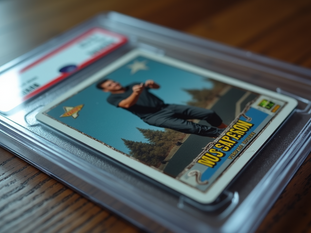
Ultimate Guide to Evaluating Potential Grades of Pokemon Cards
0
4
0
Evaluating the potential grade of Pokémon cards based on the grading criteria from CGC (Certified Guaranty Company), PSA (Professional Sports Authenticator), and Beckett involves understanding their grading scales and the specific factors they consider. Here’s a comprehensive guide:
1. Grading Scales
PSA (Professional Sports Authenticator)
Gem Mint 10: Virtually perfect card.
Mint 9: Slight imperfections but still in excellent condition.
Near Mint-Mint 8: Minor flaws such as slight corner wear or slight centering issues.
Near Mint 7: Small defects like slight edge wear or minor surface wear.
Excellent-Mint 6: Noticeable flaws like minor creasing, chipping, or noticeable wear.
Excellent 5: More pronounced defects.
Very Good-Excellent 4: Card shows wear but no major damage.
Very Good 3: Rounded corners, surface wear, and light creases.
Good 2: Heavy wear, visible creases, but no major damage.
Poor-Fair 1: Major damage, creases, and possibly torn areas.
CGC (Certified Guaranty Company)
10 Pristine: Perfect in every way, four 10 sub-grades.
9.5 Gem Mint: Nearly perfect with one minor flaw.
9 Mint: Minor imperfections visible.
8.5 Near Mint+: Slightly more imperfections than a Mint 9.
8 Near Mint/Mint: Minor wear visible.
7.5 Near Mint: More visible wear but still excellent condition.
7: Noticeable wear, minor edge chipping.
6.5: Moderate wear.
6 Excellent/Near Mint: More significant wear.
5.5 Excellent+: Heavy wear but no major damage.
5 Excellent: Heavy wear, minor creasing.
4.5 Very Good/Excellent+: Significant wear.
4 Very Good/Excellent: Heavy wear and significant surface issues.
3.5 Very Good+: More visible wear, minor creases.
3 Very Good: Heavy wear, noticeable creases.
2.5 Good+: Very heavy wear, multiple creases.
2 Good: Significant damage, creasing.
1.5 Fair: Major damage, multiple creases, possible tears.
1 Poor: Extremely heavy damage.
Beckett Grading Services (BGS)
10 Pristine: Perfect card, with no flaws.
9.5 Gem Mint: Almost perfect, very minor flaws.
9 Mint: Slight imperfections, nearly perfect.
8.5 Near Mint/Mint+: Minor wear but excellent condition.
8 Near Mint/Mint: Visible wear but no major damage.
7.5 Near Mint: Noticeable wear, minor issues.
7: More visible wear.
6.5: Moderate wear.
6 Excellent/Near Mint: Significant wear, minor creases.
5.5 Excellent+: Heavy wear but intact.
5 Excellent: Heavy wear, significant surface issues.
4.5 Very Good/Excellent+: Very noticeable wear.
4 Very Good/Excellent: Significant wear and surface issues.
3.5 Very Good+: More visible wear.
3 Very Good: Heavy wear and noticeable creases.
2.5 Good+: Very heavy wear.
2 Good: Significant wear, multiple creases.
1.5 Fair: Major damage.
1 Poor: Extremely heavy damage.
2. Key Factors for Grading
Centering
Perfect Centering: Equal borders on all sides.
Minor Off-Centering: Slightly unequal borders but still within acceptable ranges for high grades.
Major Off-Centering: Significantly unequal borders, affecting grade negatively.
Corners
Sharp Corners: No visible wear or rounding.
Minor Wear: Slight rounding or tiny nicks.
Major Wear: Noticeable rounding or damage.
Edges
Clean Edges: No chipping or whitening.
Minor Chipping: Slight edge wear or chipping.
Significant Chipping: Noticeable edge damage or whitening.
Surface
Flawless Surface: No scratches, stains, or print defects.
Minor Imperfections: Tiny scratches, print lines, or minor stains.
Major Defects: Noticeable scratches, print errors, or significant stains.
3. Evaluation Process
Step-by-Step Guide
Inspect Centering:
Measure the borders on all sides. If they are equal or nearly equal, the card has good centering.
Use a centering tool or ruler for precision.
Examine Corners:
Look at all four corners under good lighting.
Use a magnifying glass to spot minor nicks or rounding.
Check Edges:
Run your finger along the edges to feel for chipping.
Inspect for any whitening or damage along the edges.
Analyze Surface:
Tilt the card under light to spot scratches or print lines.
Look for any stains, creases, or other surface issues.
Assign a Grade:
Compare your findings with the grading scales of PSA, CGC, and Beckett.
Consider the most significant flaws first and see which grade range they fall into.
Assign a grade based on the overall condition and most prominent defects.
Tools Needed
Centering Tool: For precise measurement of card borders.
Magnifying Glass: To inspect corners and edges closely.
Good Lighting: Essential for surface inspection.
Sleeves and Toploaders: To protect the card during the evaluation process.
By following this guide and familiarizing yourself with the grading criteria of PSA, CGC, and Beckett, you can effectively evaluate the potential grade of your Pokémon cards. Remember that practice and experience will improve your ability to accurately assess card conditions.





